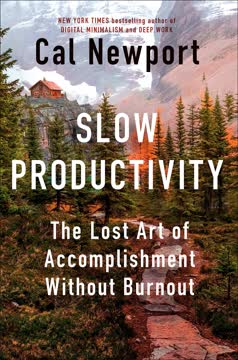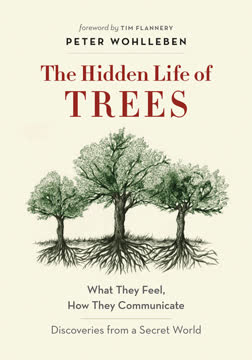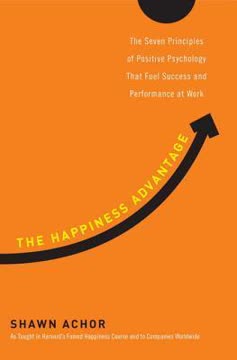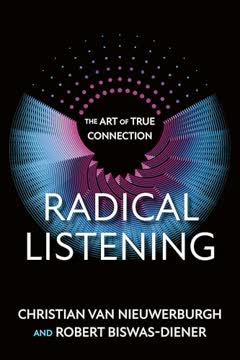Key Takeaways
1. Radical Listening is a Proactive, Intentional Approach to Connection
The most powerful aspect of Radical Listening is that it is a mutually beneficial interaction.
Beyond active listening. Radical Listening builds upon traditional active listening by emphasizing the listener's clear intention and dynamic engagement. It transforms listening from a passive reception of information into a proactive process aimed at strengthening relationships and creating opportunities. This approach recognizes that better conversations lead to better relationships, which in turn enhance overall well-being and address societal issues like loneliness and conflict.
Intentionality is key. The starting point for Radical Listening is being clear about your "why" as a listener. This positive intention—whether to connect, appreciate, influence, learn, understand, or solve—shapes the entire conversation. Without a defined purpose, listening can fall prey to internal and antisocial barriers, such as comparing, competing, mind-reading, or listening solely to inform or defend.
Mutual benefits. By focusing on the speaker's needs and approaching conversations with a positive intention, Radical Listening creates a mutually beneficial interaction. Listeners develop stronger connections, are perceived as empathetic, and experience greater well-being. Speakers, in turn, feel valued, understood, and empowered to think more clearly, fostering a wider network of support.
2. Internal Listening Skills Form the Foundation of True Connection
Listening is, largely, an internal phenomenon.
Beyond outward signs. While active listening often focuses on visible cues like eye contact and nodding, Radical Listening delves into the crucial internal processes that underpin effective communication. These hidden cognitive skills—noticing, quiet, and accepting—are essential for creating the mental space and openness required for genuine connection. They allow the listener to fully engage with the speaker's message without internal distractions.
Mental preparation. Before any external response, the Radical Listener cultivates an internal state conducive to deep engagement. This involves:
- Noticing: Attentively directing focus to important conversational elements.
- Quieting: Managing internal dialogue and emotions to create calm.
- Accepting: Adopting an open stance to the speaker's views without judgment.
Facilitating social conditions. The effective use of these internal skills facilitates the social conditions necessary for Radical Listening. By mastering these inner disciplines, listeners can ensure they are fully present and receptive, laying the groundwork for meaningful and impactful external interactions.
3. Noticing: Directing Your Attention to What Truly Matters
What we notice, it turns out, is heavily influenced by our intention.
More than just looking. Noticing is a conscious act of intentionally focusing one's attention, distinct from merely observing. It involves actively scanning for information and determining what is relevant, much like a student spotting an anomaly in NASA data that hundreds missed. Our ability to notice is profoundly shaped by our listening intention, guiding our "spotlight" of attention to specific details.
Harnessing attention. Effective noticing requires understanding and managing different types of attention:
- Divided Attention: Multitasking hinders noticing; reducing it improves focus.
- Selective Attention: Concentrating on specific information while filtering out distractions, though it can lead to "inattentional blindness" (missing obvious things).
- Shared Attention: Focusing on the same thing as others enhances connection and motivation.
Layers of information. Radical Listeners intentionally direct their attention to various categories of information, including:
- Physical: Posture, facial expressions, gestures.
- Behavioral: Actions and goals.
- Mental: Emotional state, values, attitudes, motives.
- Social: Insights into relationships.
- Linguistic: What is said, how it is said (tone, pace, jargon), and why it is said (underlying motives).
By intentionally focusing their attention, Radical Listeners can extract richer meaning and demonstrate deeper engagement.
4. Quiet: An Active Skill for Deeper Understanding and Connection
One thing we can be certain of is that quiet is a precondition for good listening.
Quiet as a skill. Radical Listening redefines quiet not merely as the absence of sound, but as an active, intentional skill. It involves strategically using silence and managing noise—both external and internal—to create an optimal environment for deep listening. This contrasts with the common discomfort many feel with silence, often misinterpreting it as awkwardness or a communication failure.
Functions of silence. Silence serves various purposes for both speakers and listeners:
- For Speakers: Selecting words, signaling end-of-turn, creating dramatic pauses.
- For Listeners: Processing information, expressing appropriate reactions, indicating assent, avoiding controversy, supporting comprehension, managing emotions.
Creating silent spaces. Radical Listeners actively cultivate quiet on multiple levels:
- Inner Quiet: Managing internal chatter and emotions to focus fully.
- Conversational Quiet: Establishing norms like confidentiality and transparency.
- Environmental Quiet: Minimizing physical distractions and signaling the conversation's importance.
Understanding and intentionally employing quiet allows listeners to concentrate, process, and respond more thoughtfully, fostering a deeper connection.
5. Acceptance: Embracing Openness, Humility, and Curiosity
In simple terms, it is the psychological acknowledgment of the situation as it is without trying to immediately make changes.
Openness without agreement. Acceptance in Radical Listening means adopting a stance of mental openness to what others communicate, without immediate judgment or the need to agree. It's about acknowledging the speaker's point of view, the situation, and even one's own limitations, fostering a pragmatic approach to dialogue. This crucial internal skill allows listeners to take in information without being distracted by their own biases or agendas.
Overcoming obstacles. Common barriers to acceptance include believing one is always right, listening with the intent to rebut, and even excessive politeness that prevents genuine engagement. Radical Listeners actively work against these tendencies by cultivating specific mental orientations.
Crucial skills for acceptance:
- Intellectual Humility: Recognizing the limits of one's own knowledge and the fallibility of one's ideas. This fosters openness to new information and opposing viewpoints, leading to more civil discourse and empathy.
- Curiosity: Actively seeking out new information and experiences, especially social curiosity about others. Treating the speaker and topic as a "mystery" boosts engagement and reduces premature judgment.
By embracing intellectual humility and curiosity, Radical Listeners can move beyond their own preconceived notions, truly hear others, and accept their experiences and values, even when disagreeing with their conclusions.
6. External Listening Skills Actively Engage and Build Rapport
Radical Listening builds on this by adding even more active skills such as asking follow-up questions.
Beyond internal processing. While internal skills like noticing and acceptance are foundational, Radical Listening also emphasizes visible, behavioral interventions that actively shape the conversation. These "external skills"—acknowledging, questioning, and interjecting—demonstrate engagement, build rapport, and invite deeper communication from the speaker. They transform the listener from a passive recipient into an active, co-creative participant.
Dynamic interaction. These skills are not merely techniques but dynamic tools used intentionally to achieve specific conversational outcomes. They are designed to:
- Acknowledge: Explicitly recognize and validate the speaker's contributions and perspectives.
- Question: Ask thought-provoking inquiries that demonstrate interest and encourage reflection.
- Interject: Strategically interrupt to show engagement, build energy, or clarify.
Demonstrating investment. The effective deployment of external skills signals to the speaker that they are truly being heard, understood, and valued. This active participation fosters a sense of connection and trust, making the conversation more productive and meaningful for both parties.
7. Acknowledging: Validating Others Through Intentional Recognition
When you engage in Radical Listening, you are providing your conversational partner with evidence that they matter.
Core of Radical Listening. Acknowledging is the act of explicitly recognizing and validating another person's efforts, perspectives, strengths, values, or principles. It is the essence of showing respect and positive regard, making the speaker feel seen, understood, and appreciated. This skill is crucial for building and maintaining strong relationships.
Seven Levels of Acknowledgment: This framework guides listeners in choosing appropriate responses:
- Denouncing: Rejecting experiences/emotions (to be avoided).
- Dismissing: Actively invalidating experience (to be avoided).
- Downplaying: Minimizing significance (to be avoided).
- Flatlining: Adopting a neutral attitude (rarely used, for sensitive topics).
- Up-Playing: Adding value through short summaries or signals (frequently used).
- Affirming: Explicitly commenting on recognition of the topic (used occasionally).
- Joining: Getting involved in the experience or emotion (used occasionally, high energy).
Building connection. Research by John Gottman on "bids" and Shelly Gable on "active constructive responding" highlights that enthusiastically "turning towards" others' positive news and efforts strengthens relationships. Acknowledging, when done authentically and culturally appropriately, boosts self-confidence and well-being, fostering deeper rapport.
8. Questioning: A Powerful Tool for Engagement and Deeper Insight
The aspect we would like to focus on is how each question posed by the listener is an invitation for the speaker to share more.
Beyond information gathering. Questioning in Radical Listening is far more than just seeking answers; it's a dynamic invitation for the speaker to elaborate, reflect, and feel heard. While closed and narrowing questions have their place for efficiency, open-ended questions are vital for exploring issues in depth, demonstrating curiosity, and provoking new thinking.
Functions of effective questions:
- Demonstrating interest: Signals engagement and encourages the speaker to continue.
- Showing humility: Validates the speaker and offers them an opportunity to contribute.
- Building relationships: Expresses commitment and investment in the person.
- Provoking new thinking: Opens doors to shifts in perspective and creative solutions.
Types of questions for Radical Listening:
- Supplementary: Requests additional detail.
- Confirmatory: Emphasizes something positive.
- Emphatic: Shows high engagement or commiseration.
- Celebratory: Invites reflection on successes.
- Future-focused: Encourages attention toward positive outcomes.
Avoiding "cluster," "rambler," "random," "Trojan horse" (disguised advice), and "rhetorical" questions ensures genuine engagement. Even micro-questions or strategic silence can function as powerful inquiries, inviting further sharing without derailing the speaker.
9. Interjecting: Skillful, Timely Interruptions Enhance Conversation
As counterintuitive as it sounds, interjection is a vital part of listening.
Reconsidering interruptions. While often perceived as rude, interjecting in Radical Listening is a skillful, engaged form of communication. It involves "overlapping speech" that temporarily takes the turn to speak but quickly returns it to the original speaker, demonstrating enthusiasm and support rather than disrespect. This contrasts with "stealing the podium" or "taking the microphone," which are genuinely intrusive.
Types of interjections:
- Minimal encouragers: Small signals like "uh huh" or "yes" to keep the speaker going.
- Humor: Lighthearted comments that build rapport.
- Alerts: Warnings about immediate issues (e.g., "He's behind you!").
- Clarification/Assistance: Helping the speaker articulate a point or understand a concept.
Cultural nuance and timing. The acceptability of interjections varies significantly across cultures, influencing perceptions of politeness and conversational flow. Radical Listeners develop "code-switching" abilities to adapt their style. Strategic timing is also crucial, with interjections being most effective when they are:
- Procedural: Managing the conversation's structure (e.g., time checks).
- Emphatic: Highlighting important points or expressing strong reactions.
- Strategic: Achieving specific goals like diffusing tension or rallying support.
Skillful interjection conveys enthusiasm and active participation, making the conversation more dynamic and connected.
10. Culture: The Invisible Architect of Listening Dynamics
At a very deep level, culture is a powerful shaper of our psychology and behavior.
Beyond visible artifacts. Culture is more than just dress or language; it's a shared way of understanding the world, influencing how people think, feel, interact, and communicate. For Radical Listening, understanding these deep cultural nuances is critical to interpreting messages accurately and responding appropriately, especially in cross-cultural interactions. Generalities can serve as guiding scripts, but individual variations must also be acknowledged.
Psychological consequences. Cultural leanings, particularly individualism versus collectivism, profoundly shape:
- View of Self: Independent vs. part of a group.
- Personal Control: Agent of change vs. adapting to situations.
- Attention Focus: Noticing objects vs. noticing context.
- Object Clustering: Grouping by category vs. by relation.
Facets of cross-cultural communication:
- Attention to Context: Low-context (direct) vs. high-context (nuanced) communication.
- Non-Verbal Behaviors: Varying use of gaze, smiling, and gestures.
- Listening Norms: Differences in conversational pace and turn-taking.
- Emotional Expressiveness: How openly and what types of emotions are expressed.
- Tolerance for Conflict: Direct vs. indirect approaches to disagreement.
- Attention to Hierarchy: Formality vs. casualness in interactions.
Radical Listeners leverage cultural intelligence to decode these layers, enhancing comprehension and fostering genuine connection across diverse backgrounds.
11. Cultivating "Fertile Ground" for High-Quality Conversations
When we use the term “fertile ground,” we are referring to environments that are conducive to Radical Listening conversations.
Environment matters. Radical Listening doesn't happen in a vacuum; its effectiveness is heavily influenced by the surrounding environment—physical, cultural, professional, and corporate. Creating "fertile ground" means intentionally shaping these contexts to be conducive to high-quality, meaningful conversations, much like a farmer prepares soil for a bountiful harvest.
Characteristics of fertile ground:
- Trust: High levels of trust, built through trustworthiness and assuming positive intent, are foundational.
- Timely Conversations: Flexibility and accessibility to engage in crucial conversations when needed.
- Possibility of Change: A belief that positive change is achievable, fostering hope and constructive dialogue.
- Autonomy: Empowering individuals to make decisions and take initiative, increasing engagement.
- Supportive Relationships: Explicit emphasis on interconnectedness and genuine care among colleagues.
Beyond individual skill. While personal listening acumen is vital, influencing the environment to support these characteristics ensures that Radical Listening can thrive across groups, teams, and organizations, leading to flourishing professionals and improved outcomes.
12. Leaders: The Catalysts for a Radical Listening Culture
A commitment to Radical Listening must start at the top of an organization.
Leading by example. Leaders are pivotal in cultivating a culture that embraces Radical Listening. Their explicit and sustained commitment, demonstrated through their own listening practices, sets the tone for the entire organization. This involves protecting time for meaningful conversations, promoting the value of such interactions, and engaging in Radical Listening with a wide range of colleagues.
Overcoming handicaps. Leaders often face inherent "handicaps" that can impede Radical Listening:
- Scope Handicap: Difficulty listening to detailed issues due to a focus on the "big picture."
- Knowledge Handicap: Tendency to rely on their own expertise and make quick decisions, potentially overlooking others' ideas.
- Efficiency Handicap: Prioritizing speed over deep conversations, limiting time for questioning fundamental assumptions.
Co-creating the environment. Effective leaders recognize these challenges and actively work to mitigate them, fostering listening agility and guarding against biases. They also understand that cultivating fertile ground for Radical Listening is a collaborative effort, best achieved through "democratic voluntary involvement," where everyone is encouraged to contribute to shaping a supportive communication environment.
Last updated:
Review Summary
Radical Listening receives high praise from readers, with an average rating of 4.08 out of 5. Reviewers appreciate its practical examples, tips, and techniques for enhancing listening skills. The book is described as easy to read, inspiring, and valuable for improving conversations and connections. It covers topics not found in other books on listening and uses accessible language and engaging examples. Readers find it helpful for personal growth, coaching, and fostering better relationships. Some note that while not perfect, it fills gaps left by other books on the subject.
Similar Books














